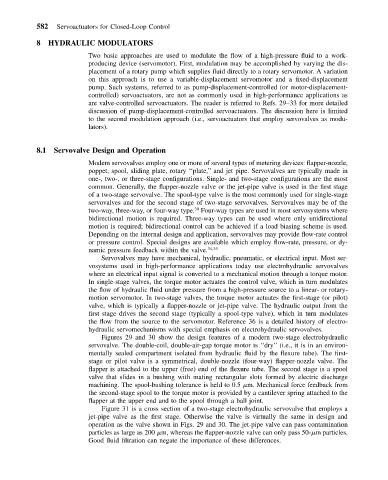Page 591 - Mechanical Engineers' Handbook (Volume 2)
P. 591
582 Servoactuators for Closed-Loop Control
8 HYDRAULIC MODULATORS
Two basic approaches are used to modulate the flow of a high-pressure fluid to a work-
producing device (servomotor). First, modulation may be accomplished by varying the dis-
placement of a rotary pump which supplies fluid directly to a rotary servomotor. A variation
on this approach is to use a variable-displacement servomotor and a fixed-displacement
pump. Such systems, referred to as pump-displacement-controlled (or motor-displacement-
controlled) servoactuators, are not as commonly used in high-performance applications as
are valve-controlled servoactuators. The reader is referred to Refs. 29–33 for more detailed
discussion of pump-displacement-controlled servoactuators. The discussion here is limited
to the second modulation approach (i.e., servoactuators that employ servovalves as modu-
lators).
8.1 Servovalve Design and Operation
Modem servovalves employ one or more of several types of metering devices: flapper-nozzle,
poppet, spool, sliding plate, rotary ‘‘plate,’’ and jet pipe. Servovalves are typically made in
one-, two-, or three-stage configurations. Single- and two-stage configurations are the most
common. Generally, the flapper-nozzle valve or the jet-pipe valve is used in the first stage
of a two-stage servovalve. The spool-type valve is the most commonly used for single-stage
servovalves and for the second stage of two-stage servovalves. Servovalves may be of the
30
two-way, three-way, or four-way type. Four-way types are used in most servosystems where
bidirectional motion is required. Three-way types can be used where only unidirectional
motion is required; bidirectional control can be achieved if a load biasing scheme is used.
Depending on the internal design and application, servovalves may provide flow-rate control
or pressure control. Special designs are available which employ flow-rate, pressure, or dy-
namic pressure feedback within the valve. 34,35
Servovalves may have mechanical, hydraulic, pneumatic, or electrical input. Most ser-
vosystems used in high-performance applications today use electrohydraulic servovalves
where an electrical input signal is converted to a mechanical motion through a torque motor.
In single-stage valves, the torque motor actuates the control valve, which in turn modulates
the flow of hydraulic fluid under pressure from a high-pressure source to a linear- or rotary-
motion servomotor. In two-stage valves, the torque motor actuates the first-stage (or pilot)
valve, which is typically a flapper-nozzle or jet-pipe valve. The hydraulic output from the
first stage drives the second stage (typically a spool-type valve), which in turn modulates
the flow from the source to the servomotor. Reference 36 is a detailed history of electro-
hydraulic servomechanisms with special emphasis on electrohydraulic servovalves.
Figures 29 and 30 show the design features of a modern two-stage electrohydraulic
servovalve. The double-coil, double-air-gap torque motor is ‘‘dry’’ (i.e., it is in an environ-
mentally sealed compartment isolated from hydraulic fluid by the flexure tube). The first-
stage or pilot valve is a symmetrical, double-nozzle (four-way) flapper-nozzle valve. The
flapper is attached to the upper (free) end of the flexure tube. The second stage is a spool
valve that slides in a bushing with mating rectangular slots formed by electric discharge
machining. The spool-bushing tolerance is held to 0.5
m. Mechanical force feedback from
the second-stage spool to the torque motor is provided by a cantilever spring attached to the
flapper at the upper end and to the spool through a ball joint.
Figure 31 is a cross section of a two-stage electrohydraulic servovalve that employs a
jet-pipe valve as the first stage. Otherwise the valve is virtually the same in design and
operation as the valve shown in Figs. 29 and 30. The jet-pipe valve can pass contamination
particles as large as 200
m, whereas the flapper-nozzle valve can only pass 50-
m particles.
Good fluid filtration can negate the importance of these differences.

